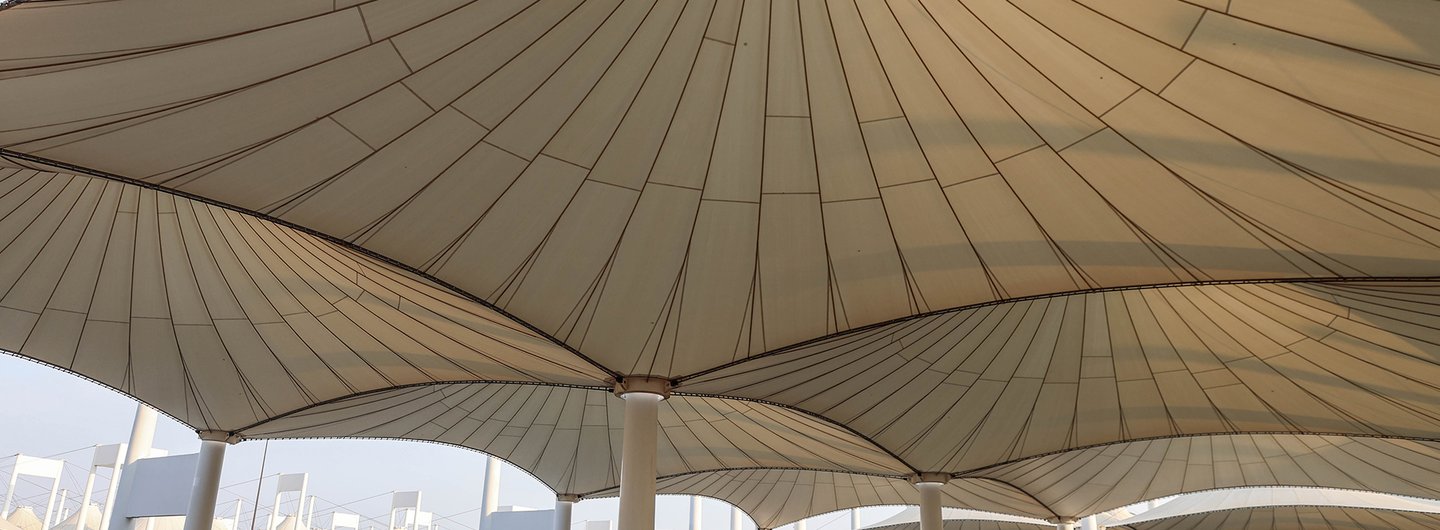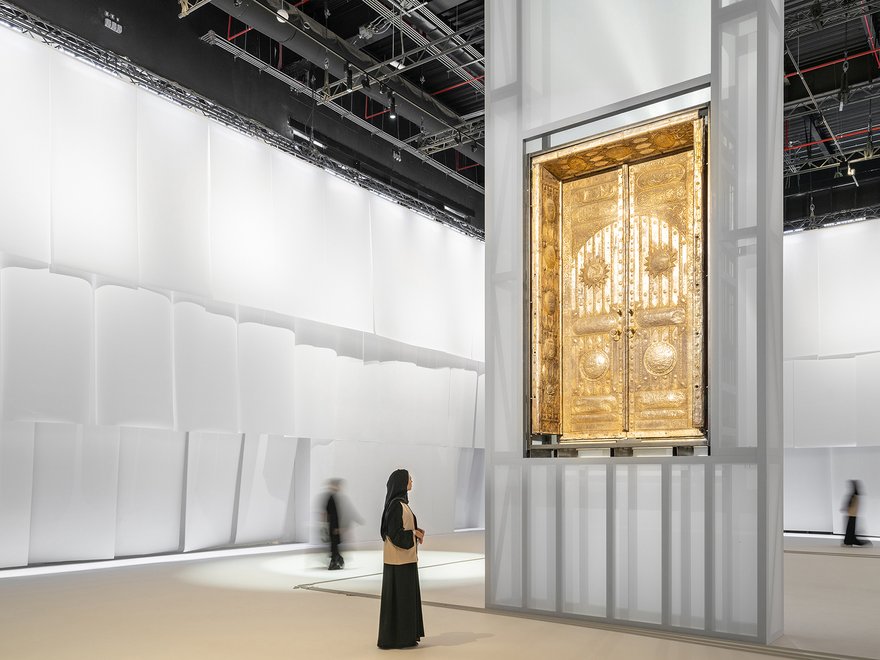
Key details
Date
- 10 May 2023
Read time
- 7 minutes
RCA Architecture tutor and architect Sumayya Vally is the artistic director of the first Islamic Arts Biennale, taking place in Jeddah, Saudi Arabia from 23 January until 23 May 2023.
Key details
Date
- 10 May 2023
Read time
- 7 minutes

Islamic Arts Biennale 2023, photograph Marco Cappelletti
The Islamic Arts Biennale celebrates past and present art of Islamic culture, reflecting the diversity of the Muslim experience worldwide. Over 60 newly commissioned works are being showcased alongside 280 historical artefacts, including the doors of the Ka’bah, intricately made sitaras (curtains which cover the Ka’bah) and some of the oldest Quranic manuscripts.
Of the participating artists several RCA alumni are included: Leen Ajlan (MA Architecture, 2022), Idris Khan (MA Photography, 2004) and Lubna Chowdhary (MA Ceramics, 1991). MA City Design tutor Dima Srouji has also created work for the biennale.
The biennale is taking place in a purpose-built venue within the iconic Hajj terminal at King Abdulaziz International Airport, Jeddah. The structure was designed to host large numbers of pilgrims from all over the world making journeys to Makkah and Medina.
The biennale’s theme, Awwal Bait, or First House, examines how the Ka’bah and the Prophet’s Mosque in Medina create a sense of belonging among Muslims worldwide. Within this the indoor instalment focuses on qiblah, the sacred direction, while the outdoors considers hijrah, migration. Hijrah is also the focus of Vally’s teaching at the RCA, where she leads ADS11 on the MA Architecture programme with Shumi Bose.
Vally discussed how she saw directing the biennale as an opportunity to redefine Islamic art and how this work intersects with her teaching at the RCA.

Islamic Arts Biennale 2023, photograph Marco Cappelletti
What does it mean to you to be the artistic director of the first Islamic Arts Biennale?
It has been a deeply personal and meaningful experience for me. To be able to fulfil a lifelong desire to make work that is rooted in and honours my own background as a Muslim and the practices I grew up with, has been incredible.
Seeing the biennale come to life through the voices and perspectives of our artists has been profound. Each of them has boldly and sensitively taken on the opportunity of this platform to contribute to an emerging discourse on Islamic arts that we hope will continue.
From the beginning, I was intent on working with this platform as an opportunity to define Islamic Art from perspectives inside of Islam. Throughout history, we have inherited definitions of Islamic Art that are defined through style, geography or chronology. I hope that the definition I am putting forth is different - in that it connects with the fundamental experiences and the life of being a Muslim or of the Muslim worlds - both at the centre and from diasporas.
What is the significance of this biennale?
This is a historic moment for the entire Muslim world, and for all of the parts of the world that Islam touches. For a long time, we have been waiting for a moment to represent ourselves from our perspectives, from our voices.
To understand the Islamic Arts Biennale as a platform for making a contribution to the discourse and canon of Islamic arts has been profoundly personal and important to me. It is important that we acknowledge that Islamic faith, Islamic practice and Islamic tradition can and should be making a creative contribution to the world.
The theme of Awwal Bait refers to the reverence and symbolic unity evoked by the Ka'bah in Makkah, the centre of our rituals, and underscores the importance of the geographic location of this biennale - a place that has witnessed migrations from across the world. At the same time, it reflects on the construction of 'home' through our spiritual and cultural rituals in Islam; acts which both unite us and celebrate our diversity and cultural hybridity.
At its essence, for me, this biennale is about giving contemporary objects a home by giving them a lineage and giving historic objects a home by giving them a future. Ultimately, herein lies the biennale’s key significance - it is a definition of Islamic art we have not seen before, not least presented in this way, on a platform of this scale. I believe that platforms like this have a role to play in understanding the profound cultural and artistic heritages around us; and in nurturing and promoting understanding between communities.
What is the aim of bringing together historic artefacts with contemporary artworks?
The concept of time actually lies at the heart of the biennale. Each time we stand up in prayer to face the Ka‘bah, Muslims are connected across worldly time and divine dimensions with beings past, present, and future who do the same, through vectors and invisible lines which connect us to our Awwal Bait, the first house, in a continual construction of spiritual belonging.
Almost all the works exhibited blur time. A number of the artists here work with embodying living archives through their collaborations, while other works interrogate this idea of preservation in a living and breathing way. I believe as an architect, that can offer something for the future of architecture. I also believe that it can certainly offer something for the future of artistic practice.
What was it like working with this specific site and did you approach adapting and using the space of the terminal?
When I first visited the Hajj Terminal on pilgrimage in 2004, I was 14 years old and the experience remained with me as a vivid memory of relatability and wonder. I returned in 2021, and felt this sensation return after many years, realising what a fertile place of imagination and long-standing connection it was.
For billions of Muslims across the centuries, Makkah has been a place formed continuously through our rituals and dreams. The physical site for the Biennale, the Hajj Terminal, designed as a contemporary gateway to Makkah, is located in the historic city of migration, Jeddah. It is imbued with significance for generations of Muslims the world over, witnessing their moment of arrival in the Kingdom.
Situated within the historic Hajj terminal in Jeddah (the southern gate of the haramayn), a monumental site layered with meaning, the biennale recognises this site as a home for the rest of the world, making it one of the most hybrid sites of cultural exchange on earth.
The scenography of the site, implemented by OMA, was particularly exciting for me to direct, because I was intent on producing scenography that draws on worlds from our rituals. The spaces in the Qiblah theme move from darkness into light through a series of spaces inspired from the sounds and atmospheres of our rituals. Outside, in the Hijrah theme, we experience a series of spaces for communing and gathering in the landscape – drawing on the energy of the Hajj terminal as a city of gathering for the world. Not white cube scenography, but really working with developing atmospheres related to rituals and spaces in the landscape for communing and gathering.
How do you apply ideas of Hijrah to Architecture on ADS11?
The aim is to challenge students to tell their own ‘stories’, to find their own appropriate tools of representation, to speculate with ambition and aplomb on the appropriate form, structure, material and programme for a uniquely African architectural vocabulary.
In Arabic, the term Hijra refers to ’emigrating’, ‘passing’ or ‘coming’. Historically, it describes the Prophet Muhammad’s flight from Mecca to Medina, escaping persecution. Included in its etymology are the words for ‘departure’, ‘exodus’ and ‘journey’.
Interestingly, in Urdu, the term has also come to mean ‘fluidity of identity’ or a ‘third’ identity, of gender and culture in particular. In this definition, the body is understood to be a literal site of transition, a vessel through which culture and identity journey, a place in which both are housed.
Traditionally, the role of architecture has been to confine or control space, shaping historical experience and social relations in static form. As a result, the history of people for whom movement, rather than being static, is the predominant experience does not find easy or direct translation into form.
Both the biennale and my pedagogical practice think through finding design form and artistic expression for aspects of our identities - found in the ritual, the migratory, mythologies, belief systems. I believe deeply that our hybrid and plural identities have different architectural worlds waiting to happen.
Why are these important ideas or themes for architecture to explore in the current moment?
Because we have inherited forms of architecture that are rooted in colonisation, slavery and ‘legalised’ exploitations of land, resources and people, which do not take into account the multiplicity of stories we have to tell. Despite global shifts in culture, movement and geography, these forms of architecture persist, and so there is an urgency to change that.
The work of ADS11 is a conscious attempt to consider what discourse coming from other perspectives might mean for architecture. In other words, by appreciating who gets to tell stories about how the world is made, this studio will empower those stories shared by voices from perspectives of difference, offering up rich and provocative possibilities for being in and making space, both at home and on the journey.
How does your teaching at the RCA intersect with your own research and work?
The nature of my practice is pedagogical and research-led, particularly searching for the expression of hybrid identities and territories – especially in African and Islamic conditions – that are both rooted and diasporic. I cannot separate my practice from my teaching and they are in constant conversation - they inform each other.
Pedagogy is a space to think through ideas slowly and experimentally - and practice is a place to test and shape those ideas in real conditions. Both of these spaces are equally important and I believe that it is absolutely necessary to work across them at the same time - so that practice feels and lives the effects of research.
Vally is the co-founder and principal of the award-winning architecture and research practice Counterspace. She designed the 2021 Serpentine Pavilion and is currently collaborating on the design of the Ellen Johnson Sirleaf Presidential Center for Women and Development in Monrovia, Liberia, the first presidential library dedicated to a female head of state.
Alongside her teaching at the RCA, Vally has taught and lectured widely including at the Graduate School of Architecture, University of Johannesburg; as Pelli Distinguished Visiting Professor at the School of Architecture, University of Illinois Urbana-Champaign; and Honorary Professor in Practice at The Bartlett School of Architecture.